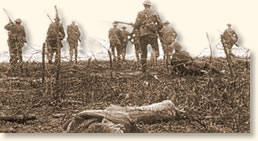|
A Death at the Battle
of the Somme, 1916
The Battle of the Somme was one of the costliest
engagements of the First World War. In the summer of 1916 the line of trenches
demarcating the Western Front stretched from the English Channel across the length of
France to the Swiss border. At Verdun, near the middle of this line, French and German troops were
bogged down in a battle of attrition. The objective of the Somme offensive was
to relieve the pressure on Verdun and to push the British line forward.
The attack began July 1, 1916 with a predominately British force clambering out of its trenches and crossing No Man's Land under
 |
Over the Top
British troops leave their trenches
Battle of the Somme, July 1, 1916 |
withering German machinegun and artillery fire. The attack soon stalled and deteriorated into disaster. On that day the British suffered almost 60,000 casualties making it the bloodiest day in British military history. Undeterred, the British command ordered the assault to continue the next day with the hope of breaking through the German lines. This attempt and the others that followed through the summer and fall months produced no break through. Finally, with the approach of winter in November, the battle was abandoned.
The final tally included 420,000 British casualties, 200,000 French and the Germans 500,000. The reward for this effort was the six-mile movement of the British front line into German territory.
Among the French troops waiting to assault the German trenches on July 1 was an American named Alan Seeger. He had graduated from Harvard in 1910 and had spent two years in Greenwich Village before moving to Paris. Alan Seeger was a poet and he thrived in the bohemian atmosphere of Paris's Left Bank. When war broke, Seeger joined the French Foreign Legion in order to defend the country he loved so much. He did not abandon his poetry. One of his compositions during this period was an eerily prophetic poem entitled "Rendezvous with Death:"
I have a rendezvous with Death
At some disputed barricade,
When Spring comes back with rustling shade
And apple-blossoms fill the air--
I have a rendezvous with Death
When Spring brings back blue days and fair.
|
Seeger kept his appointment with death on July 1, 1916 - the first day of the Battle of the Somme. He was 28 years old.
Seeger kept a diary of his experiences in the French Foreign Legion. This, along with his letters, was published in 1917. His final letter was written to a friend as he waited along with his company to be called up to join the opening attack of the Battle of the Somme:
"June 28, 1916.
We go up to the attack tomorrow. This will probably be the biggest thing yet. We are to have the honor of marching in the first wave.
I will write you soon if I get through all right. If not, my only earthly care is for my poems. I am glad to be going in first wave. If you are in this thing at all it is best to be in to the limit. And this is the supreme experience."
The rest of Alan Seeger's story is told through the words of a friend:
"At 8 o'clock on the morning of July 1st there was roll call for the day's orders and we were told that the general offensive would begin at 9 without us, as we were in reserve, and that we should be notified of the day and hour that we were to go into action. When this report was finished we were ordered to shell fatigue, unloading 8 inch shells from automobile trucks which brought them up to our position.
All was hustle and bustle. The Colonial regiments had carried the first German lines and thousands and thousands of prisoners kept arriving and leaving. Ambulances filed along the roads continuously. As news began to arrive we left our work to seek more details; picking up souvenirs, postcards, letters, soldiers' notebooks, and chatting all the time, when suddenly a voice called out: 'The company will fall in to go to the first line.'
 |
| Alan Seeger |
About 4 o'clock the order came to get ready for the attack. None could help thinking of what the next few hours would bring. One minute's anguish and then, once in the ranks, faces became calm and serene, a kind of gravity falling upon them, while on each could be read the determination and expectation of victory. Two battalions were to attack Belloy-en-Santerre, our company being the reserve of battalion. The companies forming the first wave were deployed on the plain. Bayonets glittered in the air above the corn, already quite tall.
The first section (Alan's section) formed the right and vanguard of the company and mine formed the left wing. After the first bound forward, we lay flat on the ground, and I saw the first section advancing beyond us and making toward the extreme right of the village of Belloy-en-Santerre. I caught sight of Seeger and called to him, making a sign with my hand.
He answered with a smile. How pale he was! His tall silhouette stood out on the green of the cornfield. He was the tallest man in his section. His head erect, and pride in his eye, I saw him running forward, with bayonet fixed. Soon he disappeared and that was the last time I saw my friend. . . ."
References:
Keegan, John, The Face of War (2001); Seeger, Alan, Letters and Diary (posthumously published 1917).
How To Cite This Article:
"A Death at the Battle of the Somme, 1916," EyeWitness to History, www.eyewitnesstohistory.com (2004).
|






